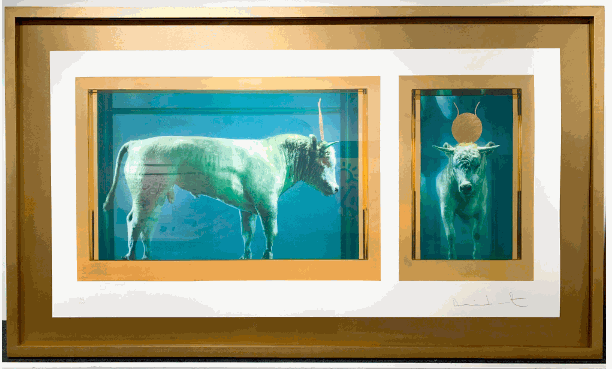Based on Hirst's 2.15 metre bull sculpture, The Golden Calf, is crowned by a solid gold disc, while its hooves and horns are cast in 18-carat gold. The piece sits on a marble base, is encased in a gold-plated box. This edition created in 2009 of 100 is framed to museum standards with burnished gold.
"The Golden Calf," which was created in 2008, is part of Hirst's "Natural History" series, where he explores themes of life, death, and the fragility of existence through the use of preserved animals and other organic materials suspended in formaldehyde.
"The Golden Calf" is a striking sculpture that features a life-size calf, seemingly made of solid gold, displayed inside a large glass tank filled with formaldehyde solution. The calf's shiny, gilded surface gives it a surreal and otherworldly appearance, as if it is an object of worship or a symbol of materialism and excess.
The title of the artwork references the biblical story of the Golden Calf, a symbol of idolatry and false worship in the Book of Exodus. Hirst's sculpture, like many of his works, combines religious and cultural references with contemporary themes, inviting viewers to reflect on the role of money, consumerism, and the value placed on material possessions in modern society.
"The Golden Calf" is an example of Hirst's fascination with the concept of mortality and the dichotomy between life and death. By presenting the calf in a state of preservation, the artwork raises questions about the cycle of life, the passage of time, and the inevitability of decay.
As with much of Hirst's art, "The Golden Calf" has garnered attention and sparked discussions about the nature of art, the boundaries of contemporary sculpture, and the deeper philosophical themes it represents. It remains an important and thought-provoking piece in Hirst's body of work and continues to be exhibited in various art institutions and collections around the world.
Provenance
Heni Editions UK
Private Collection UK
